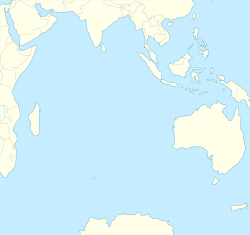Beacon Island (Houtman Abrolhos) facts for kids
| Geography | |
|---|---|
| Location |
|
| Coordinates | 28°28′31″S 113°47′09″E / 28.47528°S 113.78583°E |
| Archipelago | Houtman Abrolhos |
| Area | 5.25 ha (13.0 acres) |
| Length | 350 m (1,150 ft) |
| Coastline | 1,050 m (3,440 ft) |
| Highest elevation | 2 m (7 ft) |
| Administration | |
|
Australia
|
|
| State | Western Australia |
| Demographics | |
| Population | Uninhabited |
| Additional information | |
| Time zone | |
|
Site of Batavia shipwreck |
|
Beacon Island, sometimes called Batavia's graveyard, is a small island in the Indian Ocean. It is located off the coast of Western Australia. The island is part of the Houtman Abrolhos island group. It lies on the eastern side of the Wallabi Group.
Contents
What is Beacon Island?
Beacon Island is a special place with a unique shape and history. It is known for its connection to an old shipwreck. The island is also home to many interesting birds.
Where is Beacon Island Located?
Beacon Island is found about 80 kilometers (50 miles) west of Western Australia. It is part of the Houtman Abrolhos, which is a chain of islands. These islands are in the vast Indian Ocean.
What Does Beacon Island Look Like?
This island is shaped like the letter 'J'. It covers an area of about 5.25 hectares (13 acres). That's roughly the size of 10 football fields! The island is about 350 meters (1,150 feet) long. Its shoreline stretches for about 1.05 kilometers (0.65 miles).
Beacon Island is very low, mostly less than 2 meters (6.5 feet) high. It is made of coral pieces and sand. You can find some sandy areas and also some spots with guano (bird droppings).
A Look Back: Beacon Island's Past
Beacon Island has a very important and dramatic history. It is most famous for being linked to the shipwreck of a Dutch ship called the Batavia.
The Story of the Batavia Shipwreck
In June 1629, the ship Batavia crashed into a reef near Beacon Island. This happened during its journey from the Netherlands to Indonesia. Most of the 316 people on board survived the shipwreck. They managed to get to the smaller islands nearby.
The commander of the ship, Francisco Pelsaert, decided to seek help. He took a small boat with 47 other people. They sailed all the way to Indonesia to find rescue.
What Happened After the Shipwreck?
While Pelsaert was away, the survivors faced a very difficult situation. The ship's under-merchant, Jeronimus Cornelisz, took control. He caused a lot of trouble among the people left on the islands. Many survivors faced hardship and danger.
When Pelsaert finally returned, he found a terrible situation. He had to restore order and deal with those who had caused harm. Many of the victims from this time were buried on Beacon Island.
Later Visitors to the Island
After the Batavia incident, people like seal hunters and guano miners visited the island. This happened throughout the 1800s. In 1877, survivors from another shipwreck, the Hadda, lived on Beacon Island for five days.
Later, Crayfishermen came to the island. They built small shacks and sheds for their fishing gear.
Protecting Beacon Island's History
Archaeologists started digging on Beacon Island in the 1960s and 1970s. The Western Australian Museum did more digs in 1992. These digs helped them learn more about the Batavia shipwreck and the people who lived there.
Today, there are two government buildings on the island. They were used to support archaeological work. There is also a public toilet for visitors. Beacon Island is on the National Heritage list. This means it is a very important historical site for Australia.
Amazing Birds of Beacon Island
Beacon Island is part of a special area called the Houtman Abrolhos Important Bird Area. This area is recognized by BirdLife International. It is important because many seabirds come here to breed.
One common bird found on the island is the wedge-tailed shearwater. These birds build their nests on Beacon Island between November and May each year.



